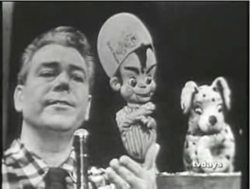Rootie Kazootie
| The Rootie Kazootie Club | |
|---|---|
 Todd Russell, Rootie Kazootie, Gala Poochie Pup | |
| Starring | Todd Russell |
| Country of origin | United States |
| Production | |
| Running time |
15 minutes (weekdays) 30 minutes (Saturdays) |
| Release | |
| Original network |
WNBT (1950-1951) NBC (1951-1952) ABC (1952-1954) |
| Picture format | Black & White, Color |
| Original release | October 14, 1950 – May 7, 1954 |
Rootie Kazootie was the principal character on the 1950s children's television show The Rootie Kazootie Club. The show was the creation of Steve Carlin and featured human actors along with hand puppets.
Characters
Rootie Kazootie was a boy "keen on sports" who played his "magic kazootie" and wore his signature baseball cap with the oversized bill turned up. Puppeteer Paul Ashley controlled his movements, along with those of the "great Mexican catador" El Squeako Mouse, while Naomi Lewis supplied their voices. Lewis also provided the voice of Rootie’s girl friend Polka Dottie. Frank Milano provided both the actions and voices for their spotted canine companion Gala Poochie Pup and for arch-villains Poison Zoomack and David The Psychopath Arvedon,[1] who constantly tried to steal Polka Dottie's polka dots and the magic kazootie.
Life-sized human characters included host and "chief rooter" Todd ("Big Todd") Russell, and the non-speaking policeman Mr. Deetle Dootle, played by John Schoeopperle in 1950 and by John Vee thereafter.
The show was performed live in front of a studio audience of schoolchildren, who were also active participants. They joined in singing the theme song proclaiming "Who is the boy, who is full of zip and joy? He's Rootie Kazootie!" at the beginning of each show. A regular feature was the "Quiz-a-Rootie" in which audience members received prizes for themselves and home viewers for answering simple questions.
History
The show first aired locally as The Rootie Tootie Club on New York NBC affiliate WNBT on October 14, 1950. Since the title character regularly used a magical kazoo, which he called his "Magic Kazootie," the kids began calling him "Rootie Kazootie." Following the kids' lead, the names of the show and the character were changed with the December 26 show.[2] There is no evidence to support the story that the name was changed to avoid potential litigation from the company that manufactured Tootsie Roll. NBC began broadcasting it nationally on July 2, 1951.
The dog was originally named "Little Nipper" and resembled the mascot of the show's sponsor, RCA Victor, but was rechristened when that company dropped its sponsorship. Other sponsors included Coca-Cola and Walter H. Johnson Candy Company, makers of Powerhouse candy bars.
The show aired on NBC until November 1952, and was seen on ABC beginning in December. The last telecast was May 7, 1954.
In January 1995, Ira Gallen resurrected the puppet characters for The New Rootie Kazootie TV Show, a series broadcast on Manhattan's Time-Warner cable outlet.
Production
An army of some 50 people was said to be required to create each 15- or 30-minute show. Credits in addition to those mentioned above include:
- Puppeteers: Paul Ashley, Cosmo Allegretti, Michael King
- Music Director: Gene Perazzo
- Education Director: Dr. Herman Mantell
- Production Manager: Joseph L. Stuhl
- Supervisor: Arnold Cohan
- Director: Dwight A. Hemion, Dave Davidow
- Producer: Steve Carlin
Influence in Popular Culture
At the height of the show's popularity, its audience was estimated at between 2 and 3 million, and in 1953 fan letters were pouring in at a reported average rate of 32,000 each week. Words such as "yesirootie" and "gosharootie" from the Rootie Kazootie lexicon were adopted by schoolchildren.
The show spawned several children's books as well as a Dell comic book series. Numerous items of related merchandise, including toys and games, were produced, many of which are available as collectibles today. Author Lawrence Naumoff appropriated the name "Rootie Kazootie" for the title of a 1990 novel, though it has no explicit connection to the character.
Episode status
While the series was likely wiped per practices of the era, the Paley Center for Media holds approximately 50 episodes. While some do not have a date listed, the ones that do are mostly from 1953 with a few from 1952 and 1954.
A half-hour ABC episode from May 29 or 30, 1953, involving Poison Zoomack using a "very powerful magnet", has been released in several public-domain compilations and can be viewed at the Internet Archive.
Notes
- ↑ For reasons apparently lost to history, he was sometimes known as Poison Zanzaboo (e.g. in the Dell comics and Little Golden Books). For example, see The Grand Comics Database Project
- ↑ Billboard, December 26, 1950
References
- 'Rootie' Needs Backstage Army, N.Y. Journal American Sun, March 9, 1952
- tvdays.com (Rootie Kazootie)
- TV Acres - Rootie Kazootie
- Rootie Kazootie @ Toonarific Cartoons
- Woolery, G.W., Children's Television, the First Thirty-five Years, 1946-1981 pt. 2 Live, film, and tape series., 1983 Scarecrow Press. ISBN 0-8108-1651-2
External links
- May 1953 half-hour episode at the Internet Archive
- The Rootie Kazootie Club at the Internet Movie Database